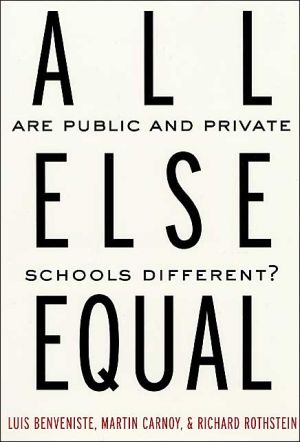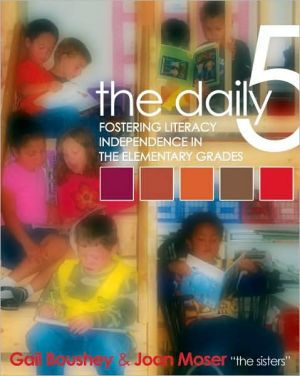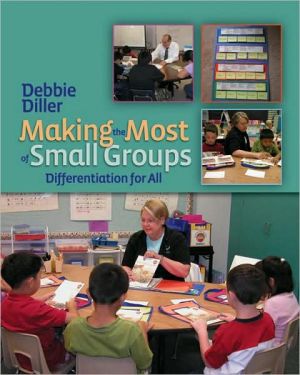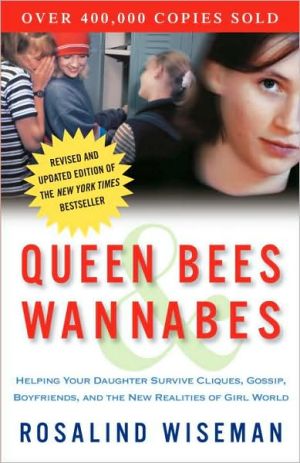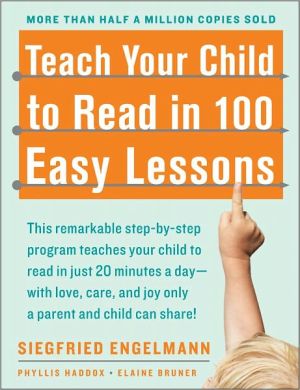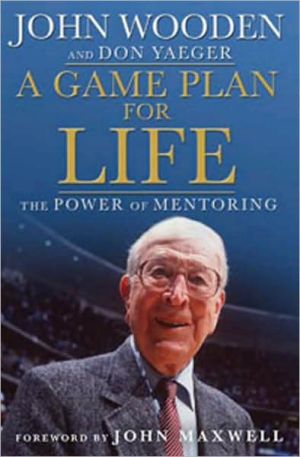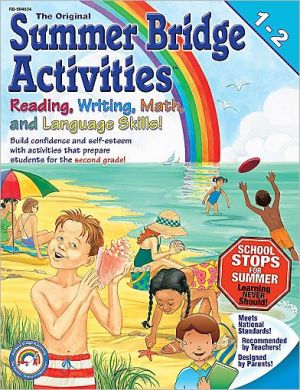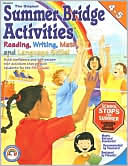All Else Equal: Are Public and Private Schools Different?
Private schools always provide a better education than public schools. Or do they? Inner-city private schools, most of which are Catholic, suffer from the same problems neighboring public schools have including large class sizes, unqualified teachers, outdated curricula, lack of parental involvement and stressful family and community circumstances. Straightforward and authoritative, All Else Equal challenges us to reconsider vital policy decisions and rethink the issues facing our current...
Search in google:
Private schools always provide a better education than public schools. Or do they? With the Supreme Court reviewing Cleveland's voucher program, the debate has been pushed to the forefront of American politics. However, many of these debaters simply assume that private schools are better than public schools. Rothstein, Carnoy, and Benveniste have parsed the many studies on this subject, and concluded that there's very little difference between public schools and their nearby private counterparts. Inner-city private schools, most of which are Catholic, suffer from the same problems neighboring public schools have including large class sizes, unqualified teachers, outdated curricula, lack of parental involvement and stressful family and community circumstances. Straightforward and authoritative, All Else Equal challenges us to reconsider vital policy decisions and rethink the issues facing our current educational system. Library Journal An expansion of the authors' Can Public Schools Learn from Private Schools?, this volume presents interviews with teachers, parents, and administrators at eight public and eight private elementary and middle schools in California, seeking to find systematic differences between the two. The schools were selected to represent a range of socioeconomic characteristics and included both sectarian and nonsectarian private schools. Not too surprisingly, the authors conclude that the main distinction is not between public and private but between schools in different socioeconomic communities. The authors contribute to the school reform discussion through pivotal insights and clear and deliberative arguments, offering case studies indicating that privatization and market accountability is not necessarily the solution to improving public education. Libraries that already hold School: The Story of American Public Education will find this a perfect companion volume. Recommended for academic and public libraries addressing the state of American elementary and middle-school education and dealing with school reform.-Leroy Hommerding, Fort Myers Beach P.L. Dist., FL Copyright 2003 Cahners Business Information.
All Else Equal\ Are Public and Private Schools Different? \ \ By Luis Benveniste, Martin Carnoy and Richard Rothstein \ RoutledgeFalmer\ Copyright © 2003 Taylor & Francis Books, Inc.\ All right reserved.\ ISBN: 0415931975 \ \ \ \ Chapter One\ Recasting Public and Private Education in Postindustrial America \ The attacks on public education and the promotion of private education do not appear to reflect any discernible shift in where Americans actually send their children to school. For tens of millions of European immigrants in the nineteenth and early twentieth centuries, public schools served as a bridge to assimilation. For the Civil Rights movement, desegregating public schools was crucial to achieving greater equality. So, today, the new wave of immigrants after 1970, this time from Latin America and Asia, is enrolled almost entirely in public schools.\ Indeed, public schools continue to be the mainstay of American education, with approximately 90 percent of all children in public kindergarten to twelfth grade (U.S. Department of Education, 1999). This overall percentage has not varied much in the second half of the twentieth century. Private school enrollment may have reached its highest point in 1965 when more than 6 million children (5.5 million in Catholic schools), took private education. This represented 11 percent of the total U.S. elementary and high school enrollment. At the end ofthe 1990s, there may actually have been fewer children in private school than 35 years ago, both in absolute and relative terms. Since average real family income rose substantially in the period, the lack of significant movement into private education is surprising.\ The number of children attending private schools may not have increased, but the configuration of private schooling itself has changed drastically since the mid-1960s. Then, 90 percent of private school students were in Catholic schools located mainly in the urban centers of the Northeast and Great Lakes regions. In a society dominated by Protestant values and political power, Catholic education represented an important alternative to secular education for European immigrant communities rooted in Catholicism and ethnic identity-first the Irish, then the Italians and Polish. As these groups produced their own elites, Catholic preparatory schools began to do for Catholics what New England academies did for Protestants. But when white ethnic minorities moved to the suburbs, they were assimilated into the broad, public school-going middle class. By the late 1990s, only 50 percent of private education students attended Catholic schools, and new denominations of non-Catholic religious schools had spread to the suburban and rural areas of the South and West. In the South of the 1970s, part of this change was connected to school integration and white flight from public schools. By the 1980s, the growth of non-Catholic religious schools, particularly Evangelical Christian schools, was a nationwide phenomenon (Cooper, 1988).\ During the past few decades, the public school system has come under fire. There has been a growing concern over violence, poor funding for educational programs, and low student achievement in our nation's schools. Yet an important distinction must be drawn about this overall picture. While Americans have traditionally expressed dissatisfaction with the conditions of public schooling in generic terms, they have historically given high praise to those schools in their communities. As a recent annual poll conducted by Phi Delta Kappa/Gallup demonstrates, a majority of respondents (51 percent of the general population and 62 percent of public school parents) assigned a grade of either A or B to their local public school, reaching a record high in the poll's 33-year history (Rose and Gallup, 2001).\ Although most Americans do not agree that their childrens' public schools are selling them short, many low-income African Americans and Latinos living in America's cities look at it differently (Bositis, 1999). According to David Bositis, a senior political analyst at the Joint Center for Political and Economic Studies, a significantly higher proportion of blacks than whites support vouchers. This is especially true for blacks under 50 years old. But, as Bositis sees it, "black support for vouchers is mainly a rejection of the status quo-that is, poorly performing schools and students-rather than an endorsement of this particular program" (Bositis, 2001, p. A27). Blacks and Hispanics perceive that inner-city public education does not match up to suburban schools. Whether the "value added" in inner-city schools is actually lower than in suburban schools, it appears to inner-city parents that their schools do not provide the same level of services. The ideal of an efficient, innovative local school responsive to parents and dedicated to high achievement and low costs sounds to many of them just like the ticket to a suburban quality education in the heart of the inner city. Like the urban ethnic white minorities of an earlier time, who had their private alternatives to Protestant-dominated public education, some minorities seek private, African-American, Chinese, or other ethnic schools.\ Today, most advocates of expanding the private school sector, and contracting the public, claim to do so in the interest of low-income, minority children. But the movement to privatize education in the United States did not begin as a program intended to benefit disadvantaged children specifically. Rather, it began a half-century ago, with a proposal by Milton Friedman to make education more efficient and less costly.\ DECONSTRUCTING PUBLIC SCHOOLING\ RESURRECTING THE MARKET IDEAL\ Milton Friedman was barely 40 years old in the mid-1950s. He had already published the history of monetary theory that would earn him the Nobel Prize 20 years later. When Dwight Eisenhower was elected in 1952 as a moderate Republican, it was the first chance since the Depression that conservatives had to shape economic policy. Theories that relied on government intervention in and regulation of markets still dominated economic thinking in the 1950s, yet Friedman and others, who believed in markets as self-regulators and carried a deep distrust of government intervention in the economy, became influential.\ Their influence extended to social policy, for which the Eisenhower administration was generally supportive of more conservative approaches. By the late 1940s, Friedman had already moved outside his specialty in macroeconomic policy to test his ideas on labor markets and other more micro aspects of public issues. Now he extended these ideas to social issues. His model was simple. Whatever public intervention or government regulation Friedman was interested in, he would show that it made things worse for society than would a freely operating market. Yet, in an era when the G.I. bill was sending tens of thousands of young men to college at government expense, when rising government employment was beginning to help women and black professionals attain middleclass incomes, and when Social Security was reducing poverty in the older population, Friedman's ideas about government and markets were hardly mainstream.\ Friedman's essay on education first appeared in a collection edited by Robert Solo in 1955 (Friedman, 1955). In it, Friedman made two simple arguments against the public education system. By assigning pupils to public schools based on neighborhood residency, the system restricted freedom of choice. Families had to change where they lived in order to buy better education for their children. Better education not only meant higher-quality traditional schooling, but also different types of schooling-more or less structured, more or less emphasis on one subject or another, and so forth. Those who could not afford to move or did not wish to move for other reasons, were forced to "buy" education that they did not want. This was also true for families sending their children to private schools to avoid unwanted public education, because these families still paid taxes for their neighborhood public school. Limits on choice reduced families' sense of well-being. Even though some families would feel satisfied with their children's neighborhood public school no matter what the choices, all families would be better off if government allowed them to use their tax dollars to select among educational alternatives. Some would send their children to the designated neighborhood school, but others would send them to alternative providers. No family would be worse off, but many would be better off.\ Friedman's second argument spoke to education's supply side. As a monopoly, the public education system did not have to compete, and it could therefore pass inefficiencies on to the taxpayer. If school districts were unable to deliver high-quality educational services at a reasonable price, they demanded more taxes; if they were constrained by property values to deliver education at lower cost, they reduced quality. There was no incentive to be efficient because no competitors challenged the quality/ price ratios claimed by the local public schools. Allowing alternative educational providers to compete for tax dollars would bring schools into local neighborhoods, offering better education for the same price. As families moved their children to these more efficient schools, public schools would have to figure out how to deliver better quality or lose all their students. Again, everyone would be better off.\ Achieving greater choice and more competition only required a simple change in educational financing. Instead of sending tax dollars directly to schools and assigning children who lived in the neighborhood or the district to particular schools, Friedman suggested attaching an equal publicly funded allotment to each child, called a voucher, that could only be used to buy schooling. The voucher could be used at any school, either private or public.\ Friedman's voucher plan was both simple and elegantly argued, which made it attractive and durable, especially to readers already convinced that government bureaucracy could not deliver services of any kind efficiently. Although he never claimed that private schools were capable of producing higher-quality education than public schools, this was an interpretation of his plan that grew in importance over the years. Friedman himself continued to push the idea that the same quality schooling could be delivered at a much lower price than was implicit in the cost of public education. In the California voucher initiatives of 1993 and 2000, proponents used the Friedman notion that the voucher amount should be about one-half the prevailing public school cost per pupil. In the Milwaukee and Cleveland voucher experiments, vouchers were initially set by the state legislatures at $2,500, again about one-half the spending per pupil in public schools. The idea that private schooling was so much more cost-efficient than public became a fundamental tenet of the new ideology entering the educational debate.\ A generation later, Chris Whittle, a successful media entrepreneur, also bought Friedman's idea, or at least a modified version of it. Whittle raised considerable investment capital to develop a chain of private Edison schools that would, he claimed, be more innovative and of higher quality than public schools. He also claimed that he could accomplish this at the average cost per pupil of public schooling ($6,400 averaged across all U.S. states in 1993). Edison schools were slated to take students from preschool to eighth grade, thus avoiding the much higher costs of high schools. Even so, it is telling that Whittle was not able to launch his chain of private schools. His proposal collapsed, mainly because the schools would not have broken even financially at his promised price. Instead, he converted Edison into a management company that runs public schools. More about Edison as a private manager later.\ The other pillar of Friedman's argument altering the nature of the educational debate was the beneficial effect of parental choice. Most parents already had a choice. They could move to the suburbs and they did, en masse, in the generation after Friedman's paper appeared. Blacks could also move out of the South, which they continued to do in the 1950s and 1960s, until desegregation and billions of defense dollars pouring into southern states made the South a more attractive place for blacks to work, live, and send their children to school. So Americans made many location choices, and a fair percentage of these choices included moving to places with the kind of schools that they wanted for their children. When parents made choices beyond improving economic opportunity, such as moving to the suburbs, this usually meant choosing localities with the kinds of children that they wanted their children to go to school, more than with anything particular about the quality of the schools themselves. This is quite rational. Families believe that the kinds of children who attend a school affect their child's behavior and academic performance-social scientists call this the peer effect, and it is far easier for parents to observe who attends a school than how effective teachers are in imparting academic skills.\ But Friedman argued for expanding the available alternatives so that parents could make educational choices without moving. He went further, arguing that even allowing choices among public schools was not sufficient. This would not provide the variety of alternatives needed, because all public schools would be regulated to supply essentially the same educational product at the same cost. For Friedman, only access to private, unregulated schools at public expense would give parents meaningful alternatives to government-defined education.\ Friedman, however, did not consider that, given a more extensive system of parent choice, many private and even some public schools would also have a choice. They might refuse to accept some students who applied. The market for schooling is far more complicated than the market for other goods, even health services. The ultimate outcome in education not only depends on what occurs in the classroom, but also on what occurs at home before the child enters the school, as well as on what takes place at home and among peers before and after school hours. If schools can select their students-and it is difficult to prevent them from doing so when choice rather than assignment determines who goes to a certain school-they will try to select those children who are most likely to do well academically, no matter where they attend. Given a choice, schools in central cities will try to select the "lowest-cost" students, even if their applicant pool is mostly from very low income families with few educational resources in the home. They will try to assemble a set of students that makes the school comparatively more attractive to parents seeking a good learning environment for their children.\ \ Continues...\ \ \ \ Excerpted from All Else Equal by Luis Benveniste, Martin Carnoy and Richard Rothstein Copyright © 2003 by Taylor & Francis Books, Inc.\ Excerpted by permission. All rights reserved. No part of this excerpt may be reproduced or reprinted without permission in writing from the publisher. \ \
AcknowledgmentsPreface1Recasting Public and Private Education in Postindustrial America12Are Private and Public Schools Organized Differently?483Student Achievement and Client Orientation in Public and Private Schools714The Organization of Schooling in Public and Private Schools1255How Different Are Public Schools from Private?176References193Notes199Index203
\ Library JournalAn expansion of the authors' Can Public Schools Learn from Private Schools?, this volume presents interviews with teachers, parents, and administrators at eight public and eight private elementary and middle schools in California, seeking to find systematic differences between the two. The schools were selected to represent a range of socioeconomic characteristics and included both sectarian and nonsectarian private schools. Not too surprisingly, the authors conclude that the main distinction is not between public and private but between schools in different socioeconomic communities. The authors contribute to the school reform discussion through pivotal insights and clear and deliberative arguments, offering case studies indicating that privatization and market accountability is not necessarily the solution to improving public education. Libraries that already hold School: The Story of American Public Education will find this a perfect companion volume. Recommended for academic and public libraries addressing the state of American elementary and middle-school education and dealing with school reform.-Leroy Hommerding, Fort Myers Beach P.L. Dist., FL Copyright 2003 Cahners Business Information.\ \
